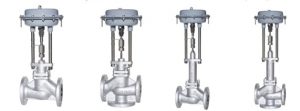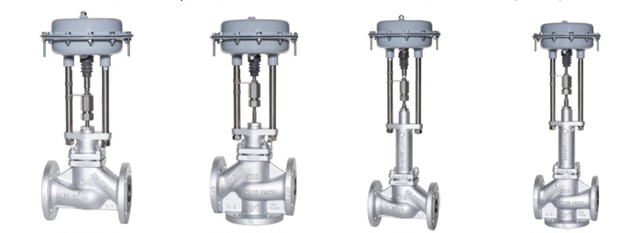What is control valve?
Control valve is a kind of industrial valve. Used in factories producing and processing products. Valves are opened and closed automatically electrically or pneumatically based on control signals. The valve can receive an on/off control signal or a proportional linear signal. With proportional linear signals, normally in industry and automation we still often use analog signals 4-20mA, 0-20mA, 0-10V, 1-5V… With analog control signal will do the valve operates on a scale from 0-100% so we can also call it a proportional valve.
What are the different types of control valves?
Conventional control valves have many types. But typical in industry commonly used are the following types:
- Pneumatic control valve.
Valves are controlled, actuated entirely by compressed air in on/off or linear mode. With this type of valve, it also has its own advantages and disadvantages. But there are a few notes everyone should refer to.

Notes for operators:
- Regularly check valve leakage: Regularly check valve leakage periodically. This is very important in the production process, especially since it directly affects human health.
- Check fluid pressure before use: Operators, users should check the inlet fluid pressure of the pneumatic control valve by installing additional pressure gauges or pressure sensors on the road. tube through which the fluid passes before entering the valve.
- Check pressure control compressed air for valve: Normally, all pneumatic control valve manufacturers must have pressure gauges to check the control pressure of compressed air before entering the valve. Because most diaphragm valves of all brands can only withstand a maximum pressure of 6bar. However, with some manufacturers of China and Taiwan, the valve will not have an additional pressure gauge for reasons of cost reduction or some other specific reasons. For these brands, the operator or the purchaser of the valve should request the option to add this pressure gauge. Because it is quite important for valve quality assurance. Or with some large American factories, they will default not to use pneumatic control valves of companies if there is no default pressure gauge (standard) for the valve.
- Check fluid temperature and ambient temperature: The problem of temperature seems to have no influence and is not important in the operation and operation of the pneumatic control valve, but it is a way of thinking somewhat. incorrect. Because when the fluid temperature is not in accordance with the valve specifications, it will lead to more severe damage, causing fire and explosion and unsafe for the operator. With improper ambient temperature, it also directly affects the valve, a lot of damage to the valve.
Note when choosing pneumatic control valve:
- Some of the most important notes when choosing a pneumatic control valve that surely every pneumatic control valve salesman needs to know to choose a valve with the correct technical features but still ensure the price problem. even for customers
- Control valve type to advise users:
- Valves have many types depending on the application and fluid to choose the most suitable valve (butterfly valve, globe valve, ball valve, gate valve …)
- The valve is normally closed or the valve is normally open. Depending on the requirements as well as the features and applications of the fluid, choose a pneumatic control valve for the customer. Pneumatic control valve is very different from electric control valve in this feature because there is a distinction between normally closed and normally open.Pneumatic control valve closing force:
- The valve closing force is very important for the valve because if you choose to lack the closing force, it will lead to the case that the valve is not closed (not 100% completely closed) leading to a leak or if you choose too much force to close the valve, it will lead to damage. The cost of the valve is stuck up, making it uneconomical for the valve.
- Fluid temperature.
- What is fluid?
- Electric control valve:
- The valve is controlled and actuated entirely by electricity. Usually the actuator part will be installed with an electric motor (AC or DC). The motor also has two types of control: linear (Proportional) according to the received signal, analog and on/off mode.
- Some notes about electric control valves when choosing valves:
- Valve size (DN).
- Valve pressure (PN): The pressure of the valve, also known as the pressure of the valve. Most users often use the word PN to refer to this feature. Usually PN10/PN16/PN25/PN40/PN63/PN100….
- Electric control valve closing pressure: Valve closing pressure, also known as valve closing force or closing pressure. However, there is one parameter that all valve manufacturers commonly use, which is Delta P (ΔP). This is the differential pressure between the inlet and outlet pressures of the valve. Based on this pressure, we can choose the closing force of the actuator for the valve.
- Inlet pressure and outlet pressure of the valve: Determining the inlet and outlet pressure of the electric control valve is an important job.
- Working fluid of electric control valve. Depending on the physical and chemical features of the fluid as well as corrosion, non-corrosion, expansion, etc., we choose the fabrication material for the valve components accordingly. This is considered one of the most important jobs because it directly affects the quality and service life of the electric control valve.
- Traffic usage. This section has Max traffic, Min traffic and average traffic.
- Fluid temperature.
- Valve use voltage.
- Type of valve for on/off or linear opening (proportional valve)
- If it is a linear valve, what signal should be determined to control the valve?
- Linear control valve – on/off control valve
- Linear control valve is a type of valve that can receive analog control signals thanks to a positioner that helps the valve to run linearly at a ratio of 0-100%. Linear valves are used a lot in industrial production plants.
- The on/off control valve will not receive an analog signal because it is not equipped with a main positioner, so the on/off valve will definitely not run proportionally.













